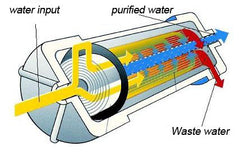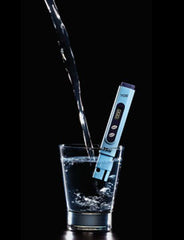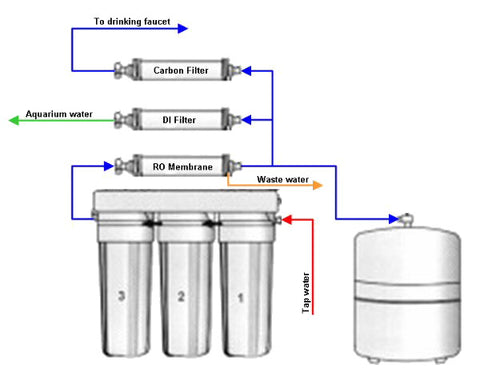RO/DI Water - What Is It and Why Do I Need It?
You probably have come across the term RO/DI water or RO water many times during your readings on saltwater or live coral reef aquariums and wondered "What is RO/DI water and do I need it?" The short answer is this, RO/DI water is highly filtered freshwater, and yes you do need it for your marine and reef aquariums, especially if you make your own salt water.
 RO/DI water is short for Reverse Osmosis De-Ionized water, or if you skip the De-Ionizing, then just call it RO water for short. Reverse Osmosis water is forced through a membrane filter cartridge that rejects even the most minute particles and only allows almost 100% pure water through. Typically RO filter units will have a 90% rejection rate meaning that 10% of the water makes it through the filter as pure water, and the other 90% gets rejected. This rejection water is suitable for plants and many salt water aquarists will run a waste water line out of the filter for rejection water to be used in gardening or to water small shrubs and plants. The remaining 10% of pure water is then used to make salt water and top off fresh water lost due to evaporation.
RO/DI water is short for Reverse Osmosis De-Ionized water, or if you skip the De-Ionizing, then just call it RO water for short. Reverse Osmosis water is forced through a membrane filter cartridge that rejects even the most minute particles and only allows almost 100% pure water through. Typically RO filter units will have a 90% rejection rate meaning that 10% of the water makes it through the filter as pure water, and the other 90% gets rejected. This rejection water is suitable for plants and many salt water aquarists will run a waste water line out of the filter for rejection water to be used in gardening or to water small shrubs and plants. The remaining 10% of pure water is then used to make salt water and top off fresh water lost due to evaporation.
 RO/DI water is preferred by most marine and reef aquarists because of the purity of the water. To test the water purity, and to make sure your RO membrane is still producing quality water, a TDS (Total Dissolved Solids) meter should be used to take readings of the water. You want a TDS reading as close to zero as possible. Typically household tap water has a TDS reading of 300 - 600 or higher. Using RO/DI water combined with a quality salt mix product will help ensure you have the best salt water for your fish, corals and invertebrates.
RO/DI water is preferred by most marine and reef aquarists because of the purity of the water. To test the water purity, and to make sure your RO membrane is still producing quality water, a TDS (Total Dissolved Solids) meter should be used to take readings of the water. You want a TDS reading as close to zero as possible. Typically household tap water has a TDS reading of 300 - 600 or higher. Using RO/DI water combined with a quality salt mix product will help ensure you have the best salt water for your fish, corals and invertebrates.
 RO/DI filters are generally 5 stage systems. The first three stages remove ammonia and chlorine, and the large particles from the water. This helps extend the life of the RO membrane. Generally the first three stages are crushed coconut shells, poly-filters and GAC (Granular Activated Carbon) or pelletized activated carbon. The fourth stage is the RO membrane, which does most of the fine particle filtration, and the fifth stage is the DI filter which passes the water through a canister filled with de-ionization beads. Some home drinking water RO/DI filters will also have a 6th stage of another GAC filter to improve water clarity and taste, however this is not necessary for aquarium use.
RO/DI filters are generally 5 stage systems. The first three stages remove ammonia and chlorine, and the large particles from the water. This helps extend the life of the RO membrane. Generally the first three stages are crushed coconut shells, poly-filters and GAC (Granular Activated Carbon) or pelletized activated carbon. The fourth stage is the RO membrane, which does most of the fine particle filtration, and the fifth stage is the DI filter which passes the water through a canister filled with de-ionization beads. Some home drinking water RO/DI filters will also have a 6th stage of another GAC filter to improve water clarity and taste, however this is not necessary for aquarium use.
 RO membranes are rated by their recommended daily production rate or GPD (Gallons Per Day). Typically you will find RO membranes with a 50 or 100 GPD rating, and you should select one that meets your water production needs. RO membranes should also be back flushed once a week to help remove sediment and to improve the lifespan of the membrane. For a definition of the acronyms used in this article and to see a list of more commonly used acronyms in the aquarium hobby, take a look at our list of commonly used acronyms.
RO membranes are rated by their recommended daily production rate or GPD (Gallons Per Day). Typically you will find RO membranes with a 50 or 100 GPD rating, and you should select one that meets your water production needs. RO membranes should also be back flushed once a week to help remove sediment and to improve the lifespan of the membrane. For a definition of the acronyms used in this article and to see a list of more commonly used acronyms in the aquarium hobby, take a look at our list of commonly used acronyms.
